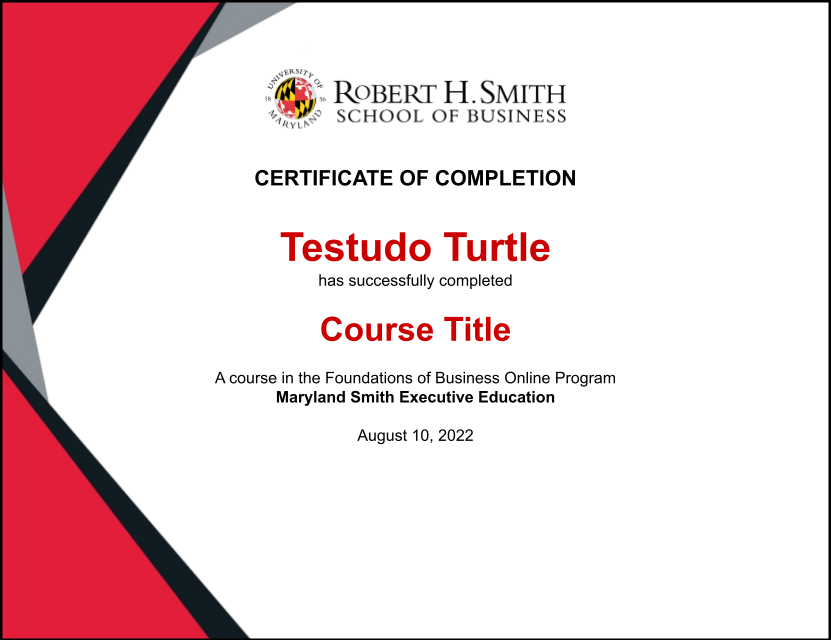Leadership and Influence
Foundations of Business Online Program
PROGRAM DETAILS
Start Dates: Enroll Immediately
Duration: 30 hours of content
Format: 100% Online
Tuition: $299
Program Description
In this course, we lay the foundation for the core capability of leaders: influence. The ultimate outcome of this course is maximizing your capacity to influence people toward a shared goal. The course is also built around the premise that influence isn't a one-size-fits-all approach. The most effective leaders match their approach to the challenge at hand. In other words, the most effective leaders are adaptive; they diagnose the situation and choose the behavior best suited for it. This course gives you a greater awareness of your readiness to influence others and create a high-impact plan for continuing your development.

Why take this course?
Learning about you is the primary objective of this course. First, you will reflect on your capacity to lead and identify how you can begin to expand that capacity. Secondly, you will learn about one-on-one relationships. You will look at ways you can gain support, build collaborative relationships, and maintain engagement as a leader with or without formal authority. Here, you begin to lay the foundation of your high-impact plan. Through these course sections, you will expand your understanding of leadership through reflection, exercises, and discussions.
By the end of this course, you will be able to take action to...
- Expand your capacity to lead
- Gain someone’s support
- Build a collaborative relationship
- Maintain someone’s engagement
Course Topics
We begin this course by discussing what leadership is and by helping you look inward to build your own social influence and leadership capacity. This is an important foundation before we explore working with individuals and working with teams.
This module will equip you to:
- Define leadership.
- Analyze what effective leadership looks like.
- Given a scenario, analyze areas of leadership that may need improvement.
- Identify ways to adapt behaviors in a leadership situation.
- Analyze your personal behaviors in order to identify areas to improve.
We define leadership as a social process of influencing others to maximize effort towards a shared goal. This module is all about using influence to gain support. That influence is rooted in different types of power that we will explore. These types of power indicate the most effective influence tactics when leading others.
This module will equip you to:
- Identify how types of personal and positional power can be used to influence others.
- Diagnose a situation and determine which power base to leverage for maximum influence.
- Recognize styles and tactics of influence in scenarios to maximize influence.
- Diagnose a situation to determine the best influence strategy.
- Assess your own influence style.
In order to have influence, you need to be able to build collaborative relationships. There are a lot of complex components that go into building these relationships, such as trust, leading with warmth, and emotional intelligence. We'll discuss these at length in this module.
This module will equip you to:
- Recognize the competencies of emotional intelligence in varying scenarios.
- Examine the benefits of leading with warmth in order to build trust.
- Reflect on your position in your network and consider areas of your network to improve or bolster.
- Analyze the emotions in a scenario to determine the appropriate behaviors to effectively lead.
- Analyze your personal emotional intelligence competencies.
How can you "maximize the sustained efforts" toward that direction or goal? In other words, how do you energize individuals to put in the effort required until the shared goal is achieved? Turns out, there are many ways you can energize others. The tough part is figuring out which you should use in any given situation. We will help you understand how to choose a deliberate method for energizing others.
We will use a Root Cause Diagnostic Framework to determine the source of poor employee performance. Then we can use Maslow's Hierarchy to consider the different layers of intrinsic and extrinsic needs people may be trying to meet. We'll explore a model from Dan Pink about intrinsic motivation, and finally, we will tackle the motivational profile interview. This is a way to facilitate a conversation around motivation.
This module will equip you to:
- Prioritize what motivates you at work and compare them to how managers typically motivate.
- Identify intrinsic and extrinsic motivators.
- Explore frameworks of motivation.
- Practice collaboratively uncovering motivational gaps using a Motivational Profile Interview.
- Diagnose potential root causes when performance misses expectations in order to choose a deliberate action.
As part of this course, you will create a personal leadership development plan. This is a high-impact plan to expand your behavioral repertoire. In this plan, you will select a behavior that you wish to develop or improve. You will describe how you will improve, set a system of accountability, and reflect on your progress. This plan will begin in the first few modules by journaling. It is important that you take the time to journal and reflect. We will offer guiding questions for your journal, as your answers will inform your development plan in the later modules.
Format & Structure
The course is completely self-paced. It will take you approximately 30 hours to complete all five modules. Activities include video lessons, readings, and self-reflection activities. Upon completing this course, you will receive a certificate of completion:

This is an asynchronous, self-paced course. That means that you can work at your own speed. There are review questions after most videos and reading. These questions are ungraded and designed for you to check your understanding of the content before moving on.
Smith Faculty

Nicole M. Coomber
